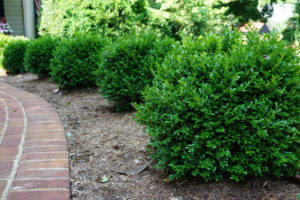Boxwood NewGen series
* Common name: Boxwood NewGen series

Boxwood NewGen Independence
Credit: Saunders Genetics
* Botanical name: Buxus NewGen
* What it is: Virginia-based Saunders Genetics has been leading the effort to develop blight-resistant boxwood varieties since the deadly Cylindrocladium fungal blight showed up in 2011.
So far its NewGen series has two varieties: Independence (‘SB 108’) and Freedom (‘SB 300’), both of which are among the most blight-resistant boxwoods now on the market as well as sporting resistance to other boxwood diseases and the boxwood leafminer insect.
Independence is a bit slower-growing and rounded in form with slightly elongated green leaves, while Freedom is faster-growing and slightly more upright in habit.
Both retain their green color well through all seasons.
* Size: Independence grows two to four inches a year to a rounded size of about three to four feet tall and wide in 15 to 20 years. Freedom grows three to six inches a year and averages about four to five feet tall and three-and-a-half to four-and-a-half feet wide in 15 to 20 years.
* Where to use: Boxwoods are the classic foundation plant and also are commonly used as rounded specimens planted in straight rows or curving lines. They also can be sheared into low hedges.
Boxwoods will grow in most light settings from full sun to full shade and are one of the best evergreens for growing in pots.
* Care: Water regularly the first full season to establish roots, then a weekly soaking is needed only in drought conditions (directly into the soil, never over top of the foliage).
Work compost into the soil at planting and maintain an inch or two of bark mulch over the soil.
Fertilizer usually isn’t needed, but a scattering of a balanced, organic, granular fertilizer is optional early each spring.
To keep plants neat, full, and to the desired size, shear once or twice a year (end of winter and early summer).
* Great partner: Ring the base of NewGen boxwoods with snowdrops or dwarf daffodils for spring color, then in May front them or interplant them with summer annuals, such as petunias, vinca, blue salvia, geraniums, celosia, or dwarf angelonia. Variegated liriope, sedges, dwarf fescue, and/or Japanese forest grass make good perennial-plant contrasts.







